
The Prevailing Epidemic
"Ah! you may laugh, my boy; but it's no joke being funny with the influenza!"
"Ah! you may laugh, my boy; but it's no joke being funny with the influenza!"
This print is recorded as anonymous at the source site, but I think the "JL" bottom left of the sketch (as well as the general illustration style) matches up well to the English caricaturist, John Leech, from the mid-1850s.

The Quack Doctor
Anonymous, date unknown (?late 18th, early 19th c.)
Anonymous, date unknown (?late 18th, early 19th c.)
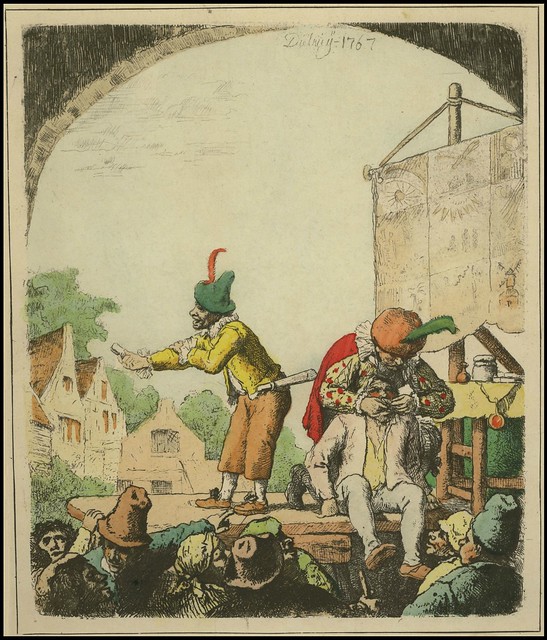
Toothpuller Entertaining in Public
Artist unknown, 1767
Artist unknown, 1767
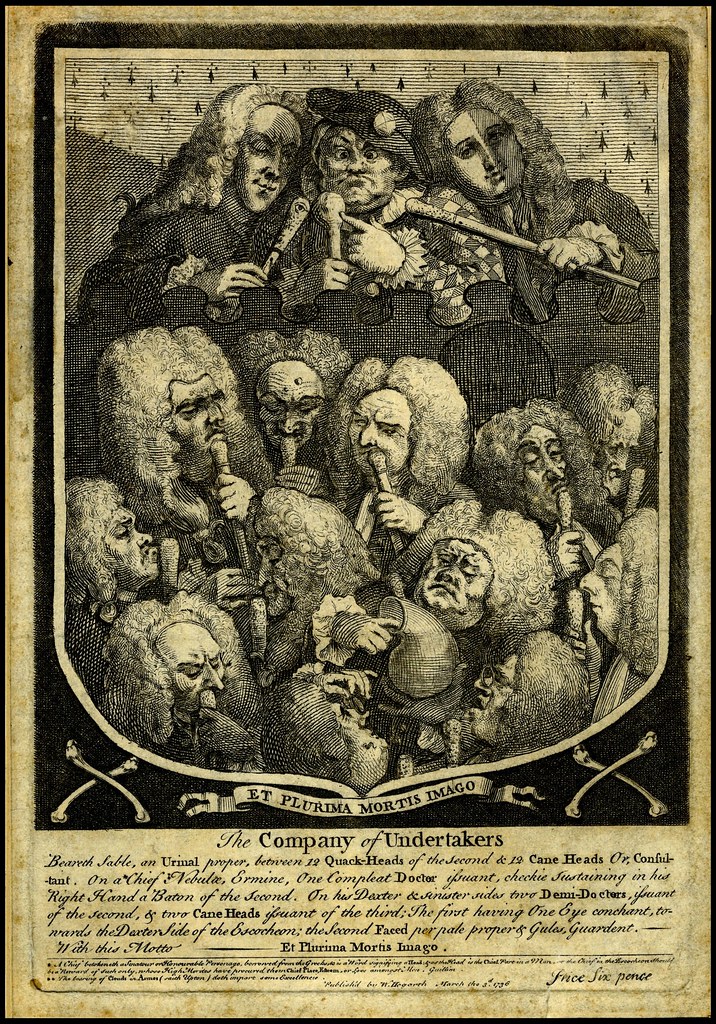
The Company of Undertakers
::: Beareth Sable, an Urinal proper, between 12 Quack-Heads of the second & 12 Cane Heads Or, Consultant. On a Chief Nebuloe, Ermine One Compleat Doctor issuant, checkie sustaining in his Right Hand a Baton of the second. On his Dexter and sinister sides two Demi-Doctors, issuant of the second, & two Cane-Heads issuant of the third; The first having One Eye conchant, towards the Dexter Side of the Esocheon; the Second Faced per pale proper & Gules, Guardent.
With this Motto - Et Plurima Mortis Imargo :::
Designed/engraved by William Hogarth, 1736
"[This is] Hogarth's delightful commentary upon the medical profession. Represented within a satirical coat-of-arms the engraving is bordered in black, like a mourning card. Beneath it are a pair of ominous crossbones and the motto, "Et Plurima mortis imago" -- 'And many an image of death'.Incidentally, a (much crisper/clearer) copy of this print was reissued later minus the text below the illustration, but bearing the title, 'Consultation of Physicians'.
The three major doctors inhabiting the upper portion of the coat-of-arms were based upon actual practitioners. In the centre of this trio is a figure dressed in a clown's suit which Hogarth refers to as "One Compleat Doctor". This figure was actually a woman named Sarah Mapp, a well known bone-setter. To her left is a feminine faced physician meant to portray Joshua Ward ('Spot Ward'), a doctor who had a birth-mark covering one side of his face. To her right, resides John Taylor, a well known oculist of the day. Taylor, it is reported, had only one eye. These physicians apparently lack the skills to heal themselves.
The lower portion of the coat-of-arms contains twelve more quack doctors. Most are occupied in sniffing the heads of their canes, which, in the eighteenth century, contained disinfectant. Three doctors, however, are absorbed by the contents of a urinal. Their expressions range from sour to unintelligent." [source]
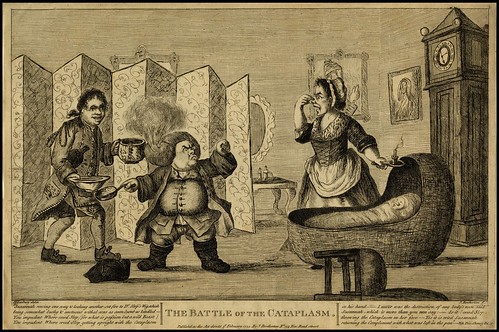
The Battle of the Cataplasm
Artist: JW Bunbury (pub'd by J Bretherton, 1773)
Artist: JW Bunbury (pub'd by J Bretherton, 1773)
"One of a series of illustrations to Laurence Sterne's 'The Life and Opinions of Tristram Shandy, Gentleman' showing Dr. Slop and Susannah exchanging abuse. Dr. Slop stands, with his wig burning, about to throw cataplasm* in Susannah's face. Susannah stands behind the cradle in which lies the infant Tristram, a plaster across his nose, as she holds her nose and a candle."*
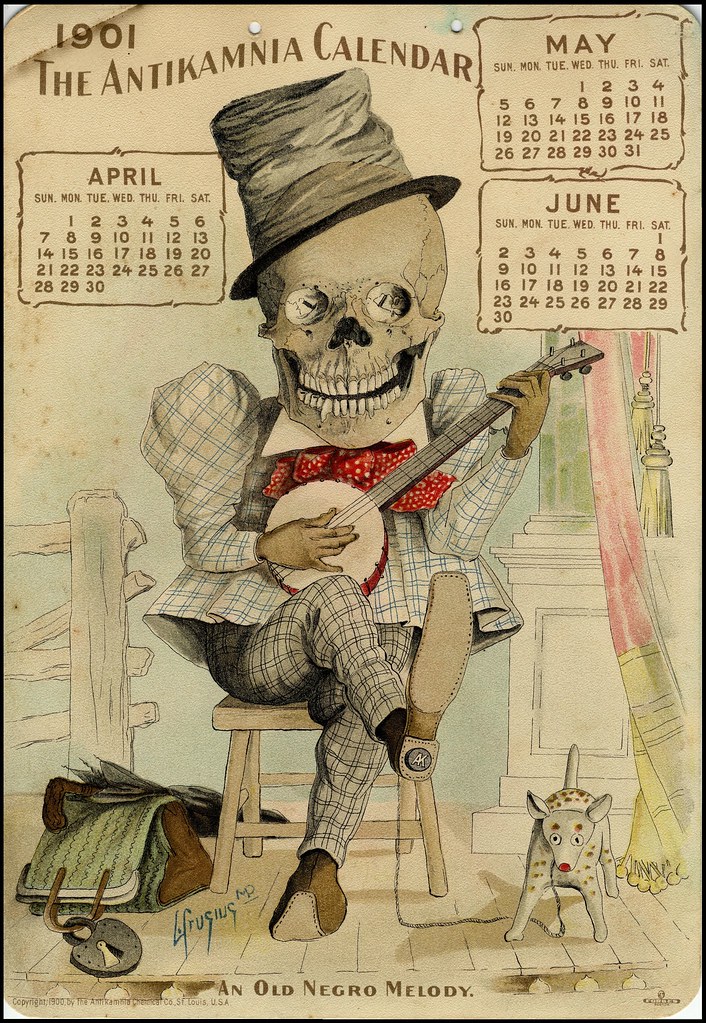
An Old Negro Melody
IN: The Antikamnia Chemical Company Calendar, April-June, 1901
IN: The Antikamnia Chemical Company Calendar, April-June, 1901
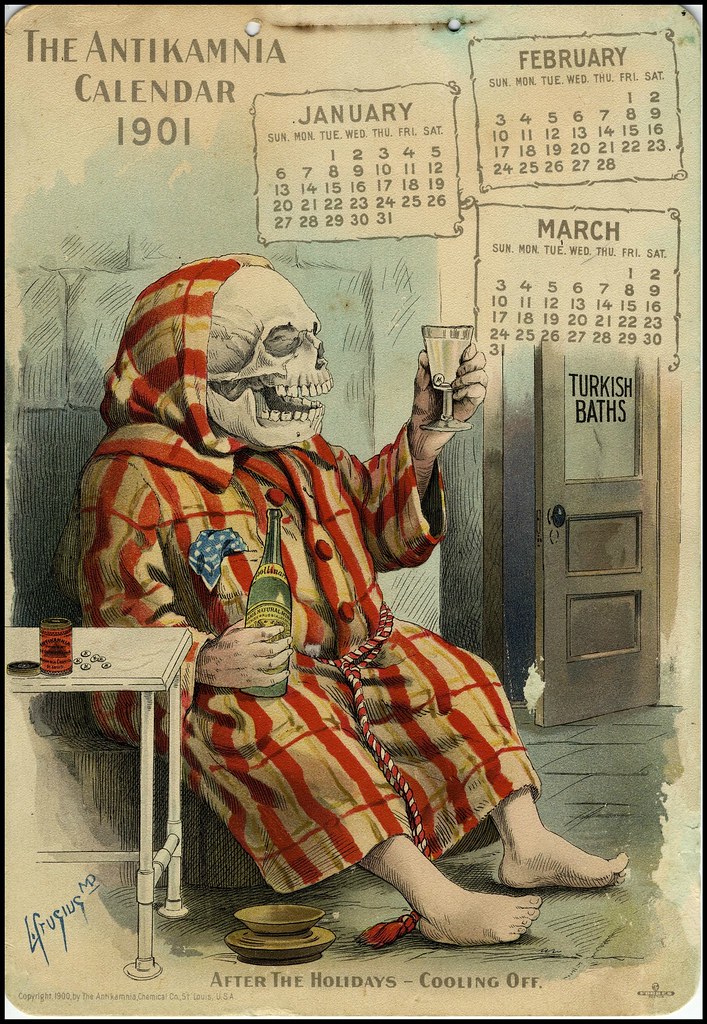
After the Holidays - Cooling Off
IN: The Antikamnia Chemical Company Calendar, Jan-March, 1901
IN: The Antikamnia Chemical Company Calendar, Jan-March, 1901
***See: The Antikamnia Chemical Company post on BibliOdyssey for many more related images and background.
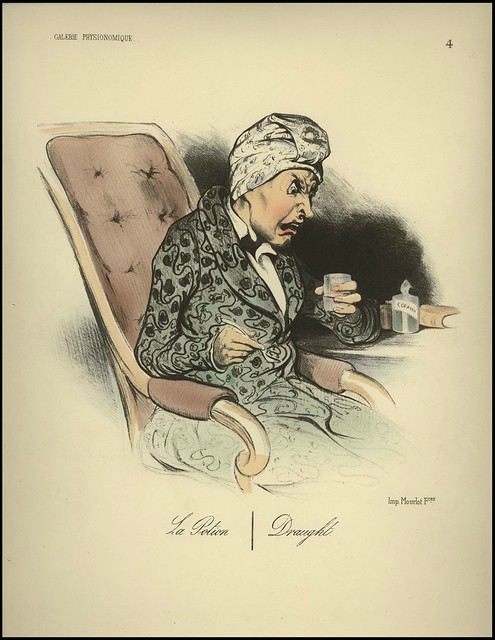
La Potion Draught
A man is taking a draft of Copaiba medicine for his cough.
IN: 'Le Charivari', November 1836 ('Galerie Physionomique') by Honoré Daumier
The 'Galerie Physionomique' was a series of 25 lithographs that appeared in 'Le Charivari' between Nov. 1836 and Dec. 1837.
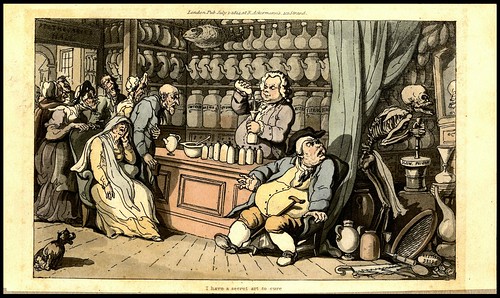
I Have a Secret Art to Cure [Each malady, which men endure]
Thomas Rowlandson's illustration from 1815 first appeared in the classic 2-vol. publication, 'The English Dance of Death'.
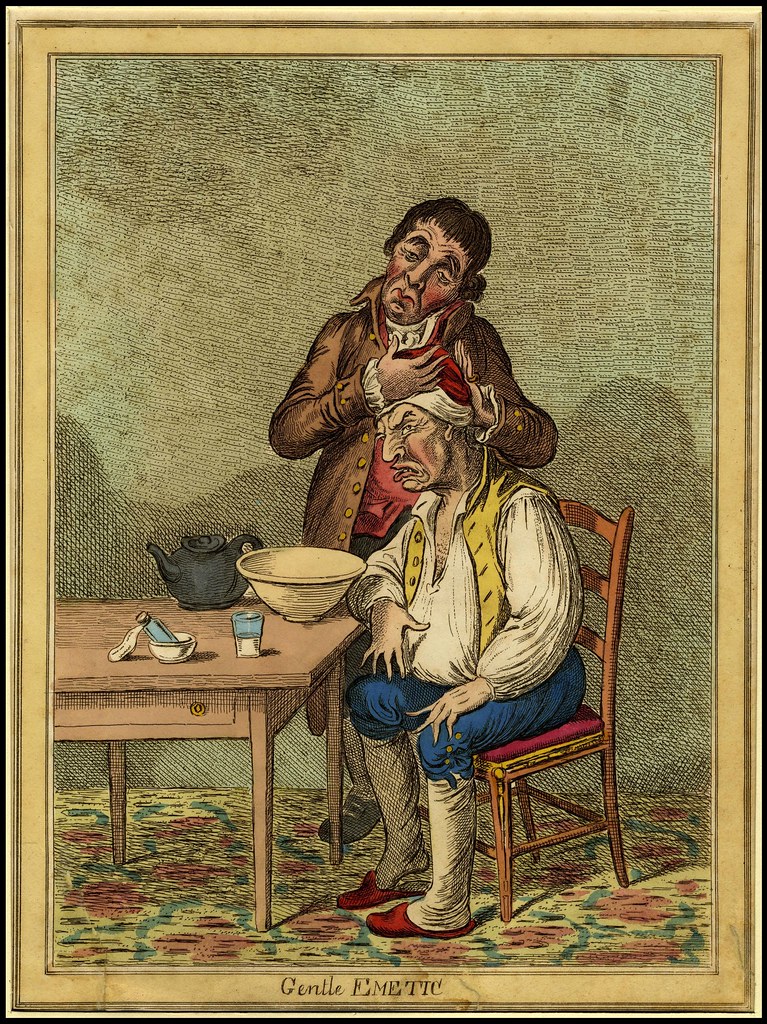
Gentle Emetic (by James Gillray, 1804)
"An emetic is a medicine that produces nausea and vomiting. “Puking” was considered to be another way to restore balance to the body. In this etching, a man and his physician [..] patiently wait for the effects of an emetic. The physician solicitously holds the man's head in his hands while the patient looks extremely uncomfortable. A bowl on the table awaits the contents of his stomach. The use of “gentle” in the title is definitely tongue-in-cheek." [source]
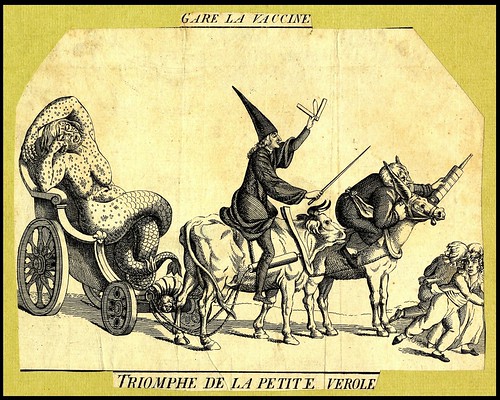
Gare la Vaccine
Triomphe de la Petite Verole
(Mind the Vaccine, Triumph of Smallpox)
Triomphe de la Petite Verole
(Mind the Vaccine, Triumph of Smallpox)
Vaccination had become quite widespread in France and England by the beginning of the 19th century and was energetically attacked by fearmongers in satirical pamphlets showing victims acquiring vaccine-host-animal qualities, for instance.

Breathing a Vein
Etched engraving by James Gillray 1804, published by H Humphrey, St James St. London
"Bloodletting, or phlebotomy, had been a standard medical practice since antiquity. It entailed withdrawing a considerable amount of blood from a person in order to cure disease. Blood was thought to build up in excess and then stagnate in certain areas of the body. Removing the extra blood would restore the natural balance of the body.
In this etching Gillray demonstrates venesection, which he calls “breathing a vein.” The title suggests that the procedure was a pleasant way to allow the vein a little air. The reality of the procedure was something else, as the cartoon suggests. A tourniquet was placed above the elbow, the artery in the forearm was punctured by a lancet, and the blood, gushing like a geyser, was captured in a bowl." [source]
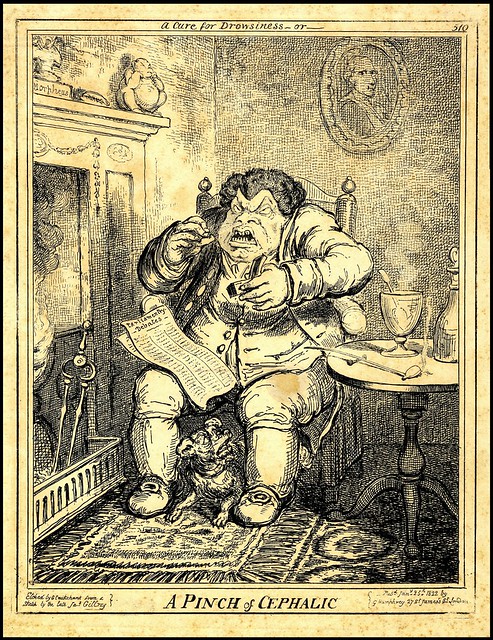
A Curse for Drowsiness -or- A Pinch of Cephalic
Engraving by George Cruikshank after a sketch by (the late) James Gillray and published by H Humphrey, St James St. London, 1822. [in colour]
A gouty old John Bull, seated with his brandy, water and pipe, takes a pinch of snuff.
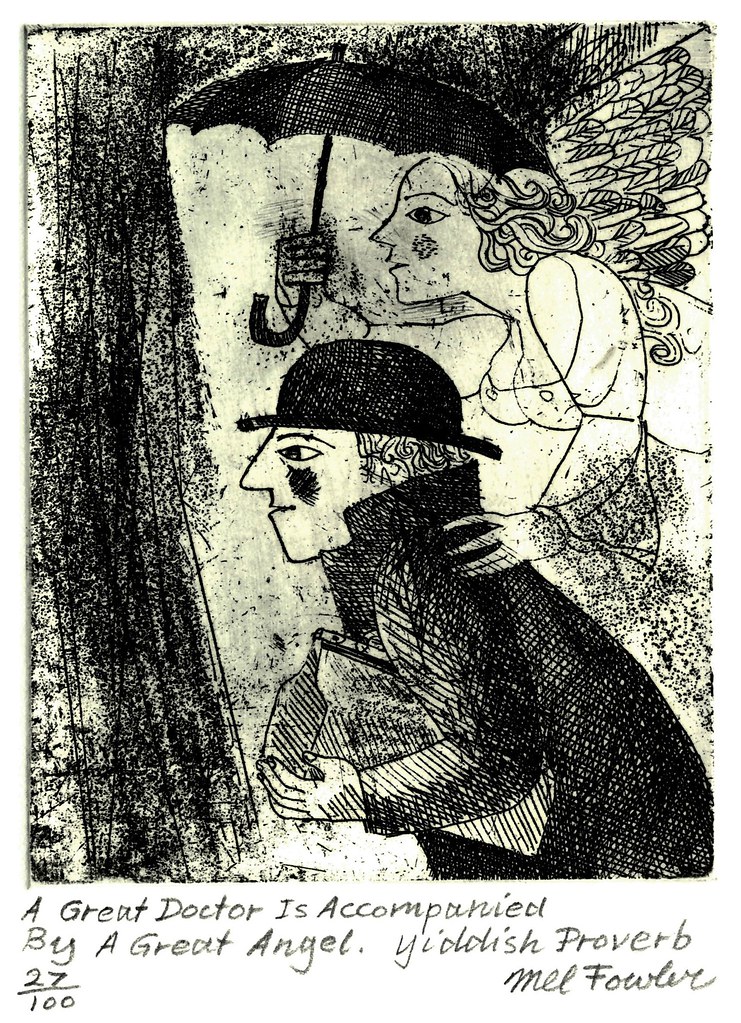
A Great Doctor is Accompanied by a Great Angel
[Mit a groissen roifeh gait a groisser malech]
Undated etching by Mel Fowler (d. 1987)*
[Mit a groissen roifeh gait a groisser malech]
Undated etching by Mel Fowler (d. 1987)*
Waring Historical Library at the Medical University of South Carolina offers up a collection of medical caricatures through the collaborative Lowcountry Digital Library.
- Previously: medicine; science.
- All the images above were spliced together from screen shots.
- Amazon: Thomas Rowlandson - George Cruikshank - James Gillray - William Hogarth.



















No comments :
Post a Comment
Comments are all moderated so don't waste your time spamming: they will never show up.
If you include ANY links that aren't pertinent to the blog post or discussion they will be deleted and a rash will break out in your underwear.
Also: please play the ball and not the person.
Note: only a member of this blog may post a comment.